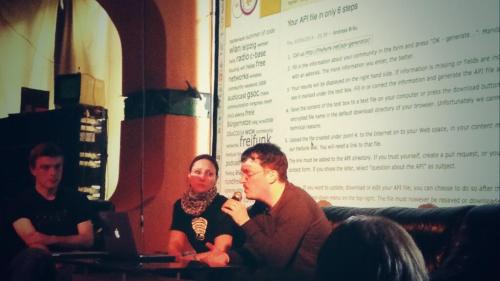This is the final blogpost for my GSoC project for the Freifunk-API Query Client.
Goals
We want a comfortable tool to query all the Freifunk API files as there are nearly 100 communities all over Germany providing their data. There are already several applications like our community map, a common calendar, our feed aggrator or the community podcast collector. But it’s still hard to find communities by properties like routing protocols or focus topics.
Challenges
When we began this project we only planned to query the generated JSON data for the community in a browser and additionally provide query results via a webservice. But then we talked to several people and we heard about DeepaMehta with features like connectors to OpenStreetmap. So we did something what you don’t do normally: We changed our project goals before the midterm evaluations.
DeepaMehta is not just another database product, it provides a different way to store and handle data. It uses a graph to store connections between items and allows to modex complex datatypes and associations between them. We had to change our mind and had to learn a new kind of thinking. The API data is constantly evolving and changing and there a lot of cross-references in the data e.g. links to various nodemaps. We think the switch to DeepaMehta is useful because we can query the graph and add new relations and data without problems.
It’s difficult to handle different spec versions if you want to query all API files, because some fields changed, other fields were added to the specs or got another meaning. In an ideal world all communities update their files as soon as possible. But we all know, it will never happen like that. As a workaround we first focused on less fields, available in all versions.
What we got
We’re able to import communities from the API directory as a base entity. We also tried some different ways to import and store the specs, but we need some improvements here. By using the summarized API file, the import of our payload can be done via the DeepaMehta REST API.
The switch to DeepaMehta brought a lot of complexity to the project and I’m personally not happy my results at this point because I had trouble to spend enough time for the project. Additionally some basic problems like dealing with changing schema and data import are not really solved well at this point. The data is in DeepaMehta and can be queries with the included client but it’s not in a state where it’s usable for the community.
Overall the GSoC was an interesting experience for me. Through I’ve failed to set aside enough time for the tasks. The timely overlap with university lectures does not make it easier. So I can only recommend to know beforehand that you’ll have enough time to accomplish your goals. But the support from the Freifunk community was always great and helpful! As the project is not a state that can be considered ‘ready’ I’m continuing working on it.
Future Plans
I definitly want to finish the work at least to point where it can be used by the wider Freifunk community.
The default DeepaMehta client isn’t designated to query a lot of fields like our API provides. Here we need a new web based client to provide users an interface to select fields and get a proper response.
Work will continue on integrating the API data and DeepaMehta.
Repository: https://github.com/freifunk/query.api.freifunk.net


